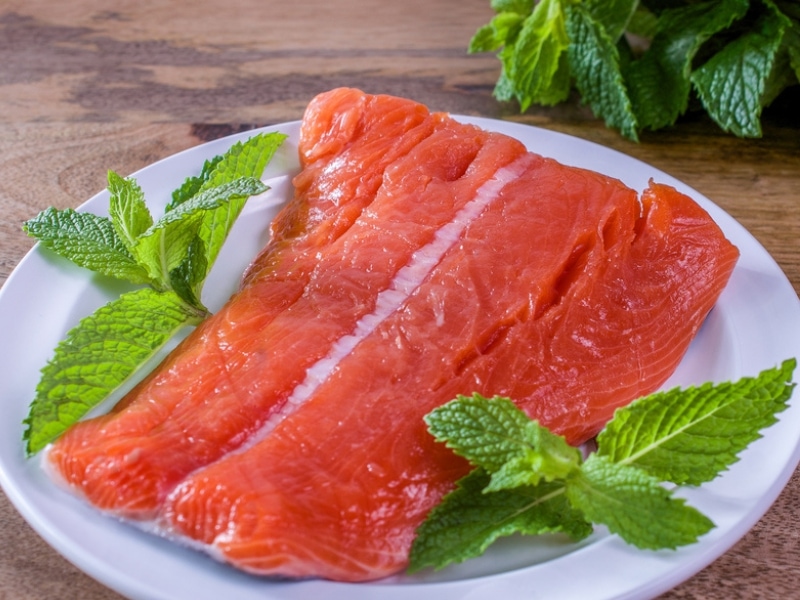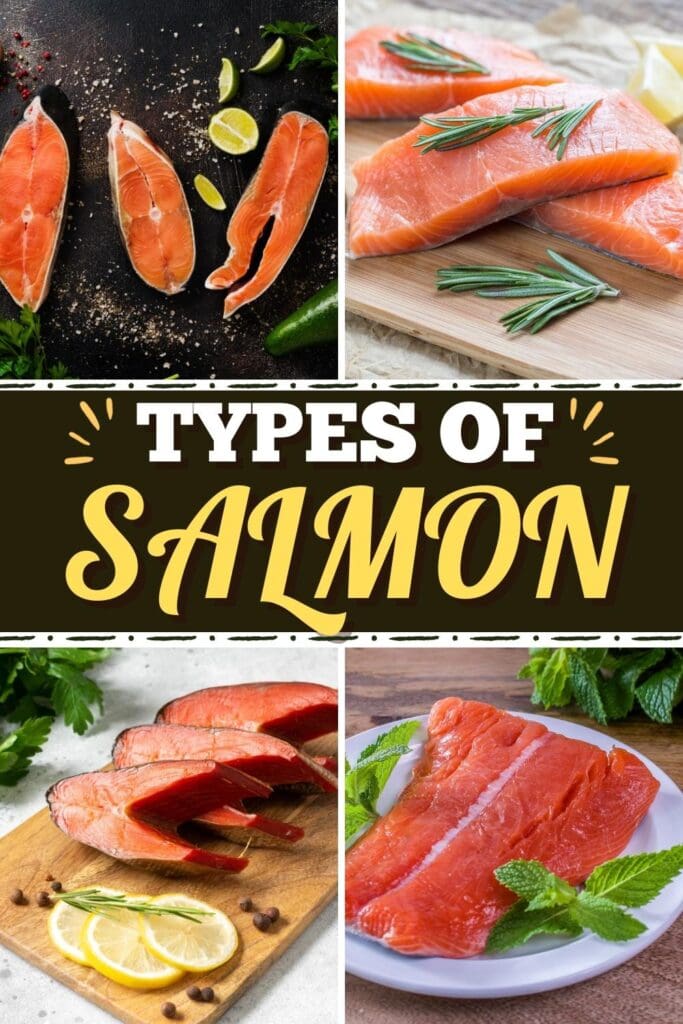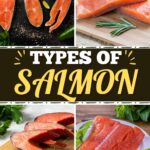There are six different types of salmon, and each one is unique. The varieties include King, Sockeye, Coho, Atlantic, Humpback, and Chum.
With its rich, fatty flavor, versatility, and its impressive array of health benefits, salmon is a favorite among many people.

But have you ever paused at your local seafood market, puzzled by the different kinds to choose from? You’re not alone! It can be confusing, especially since some types of salmon go by several names.
Whether you enjoy grilled, roasted, or steamed salmon, understanding the types of salmon is crucial.
So, let’s dive in and discover which types of salmon suit your palate and dietary preferences best!
Wild vs. Farmed Salmon
But first, let’s talk about the difference between wild and farmed salmon.
Wild salmon, harvested from natural water bodies like oceans, rivers, and lakes, feeds on a diverse diet. Farm-raised salmon, in contrast, are fish bred on a calculated diet.
The diets result in stark nutritional differences. Wild salmon is rich in minerals, while farmed packs more vitamin C, saturated fat, and calories.
Research also shows that farmed salmon might have higher contaminant levels than wild. Both, however, are excellent omega-3 sources.
For an added health benefit (and if your budget allows), opt for wild salmon. For this, you’ll want to go for Pacific salmon varieties: King, Sockeye, Coho, Pink, and Chum.
Not that Atlantic salmon is not a great choice as well. But most Atlantic salmon available today is farm-raised.
Types of Salmon
1. Chinook/King

Chinook, hailed as King salmon, earns its regal reputation with its unparalleled taste and texture.
Scientifically termed Oncorhynchus tshawytscha, Chinook’s flavorful flesh ranges from white to red. Boasting a high-fat content, this substantial fish is brimming with omega-3s.
Growing up to five feet and tipping the scales at over 100 pounds, King salmon is a true giant!
Its kingdom stretches from the temperate Pacific waters of Southern California to the icy rivers in Northern Alaska.
2. Sockeye/Red

Sockeye salmon, scientifically known as Oncorhynchus nerka, is captivating with its vibrant red-orange flesh and full-bodied flavor.
Often dubbed “reds” for their signature hue, they turn a striking red as they swim upstream to spawn.
Leaner and more compact than their royal counterparts, the Kings, Sockeyes are also easier on the wallet.
Usually smoked, these Alaskan natives pack a flavor punch some describe as the quintessential salmon taste.
3. Coho/Silver

Coho salmon, or Oncorhynchus kisutch, is often referred to as Silver Salmon because of its striking silver skin. It’s primarily harvested from Alaskan waters and the Northern Pacific.
Featuring bright red flesh, Coho presents a slightly tender texture compared to Chinook, with a beautifully balanced flavor profile.
It’s not as praised as the Kings or the rich Sockeyes. But Coho’s medium fat content and subtler taste make it a solid choice.
Because it’s smaller, Coho salmon is ideal for cooking whole.
4. Humpback/Pink

Humpback or Pink Salmon, scientifically named Oncorhynchus gorbusha, is the most abundant among Pacific salmons.
These salmon develop a distinctive hump on their backs during spawning, earning them the nickname “humpies” or humpback salmon. With light-colored flesh, they’re known for their mild flavor and low-fat content.
Weighing between 2 and 6 pounds, Pink salmon is versatile and is available fresh, frozen, smoked, or canned.
They’re primarily sourced from Alaskan waters but are also found along the coasts of Washington and Oregon.
5. Chum/Sliverbrite/Keta/Dog

Chum salmon, scientifically termed Oncorhynchus keta, is a versatile player in the salmon family. Also known as Dog salmon for its canine-like teeth, Chum is primarily harvested from Alaskan waters and is typically sold canned or frozen.
It has light to medium-colored flesh and lower fat content. It’s also smaller, often weighing in at around 8 pounds.
One of its crowning glories is its roe, which is notably larger and more flavorful than other salmon roes. In fact, it’s the star ingredient in Ikura or salmon caviar.
6. Salmo Salar/Atlantic

Last, say hello to the Atlantic salmon, the solitary fish not from the ocean.
It’s also exclusively available as farmed. With endangered wild populations, it’s raised on specialized diets, resulting in a mild flavor but larger size.
Its farm-raised nature makes it a more affordable option compared to wild salmon. This is great if you’re looking for a budget-friendly choice without compromising on taste.











